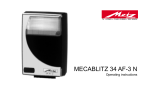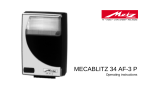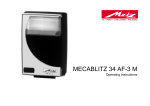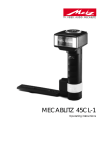Download Metz 34 AF-3 C Camcorder User Manual
Transcript
TV • VIDEO • CAMCORDER • MECABLITZ MECABLITZ 34 AF-3 C Operating instructions Foreword Dear Customer, Please read these operating instructions carefully, even if, at first sight, some points may not appear to be of interest. Our design work placed particular value on ensuring that operation of the mecablitz is as simple as possible, but it should be noted that the system cameras for which the flashgun is intended offer a great diversity of capabilities. We wish you much pleasure with your new Metz flashgun in conjunction with a Canon EOS system camera to light up the darkest points, and for creative flash lighting. We thank you for your confidence in our mecablitz MB 34 AF-3C. The MB 34 AF-3C flashgun has been especially designed for Canon EOS system cameras. IMPORTANT: Never mount the flashgun in the accessory shoe of any other system camera, otherwise the flashgun’s foot or the camera’s accessory shoe can be destroyed! The dedicated contacts in the foot of the MB 34 AF-3C only support the controlling commands of Canon EOS system cameras. The following pages give details for the correct operation of the mecablitz flashgun and summarize its fields of application. 2 Contents 1. 2. 2.1 2.2 2.3 2.4 3. 3.1 3.2 4. 4.1 4.2 4.3 4.4 5. 5.1 6. 6.1 6.2 7. 7.1 7.2 8. 9. 9.1 10. 11. Use of flash in the program modes . . . . . .32 Special functions not supported by flash . .32 Autofocus measuring flash . . . . . . . . . . .33 Flash techniques and flash functions . .34 Automatic fill-in flash . . . . . . . . . . . . . . . .34 Lighting and attachments . . . . . . . . . . . .35 Care and maintenance Manual firing button Troubleshooting . . . . . . . . . . . . . . . . . . .36 12. Technical data . . . . . . . . . . . . . . . . . . . . .37 Lightning distances . . . . . . . . . . . . . . . .38 Safety instructions . . . . . . . . . . . . . . . . .23 Preparing the mecablitz for use . . . . . . .24 Power supply . . . . . . . . . . . . . . . . . . . . . .24 Loading and replacing the batteries . . . . . .24 Automatic flashgun cut-out circuit . . . . . . .25 Mounting/Removing the mecablitz . . . . . . .25 Setting the mecablitz into operation . . .26 Preconditions . . . . . . . . . . . . . . . . . . . . . .26 Switching the flashgun on and off . . . . . . .26 Flashgun instructions to the camera . . .27 Flash-ready indication . . . . . . . . . . . . . . . .27 Automatic flash sync speed control . . . . . .27 Correct-exposure indication . . . . . . . . . . .27 Information displayed in the camera’s viewer . . . . . . . . . . . . . . . . . . . .28 TTL flash control . . . . . . . . . . . . . . . . . . .29 E-TTL flash control . . . . . . . . . . . . . . . . .30 Flash synchronisation . . . . . . . . . . . . . . .31 Normal synchronisation . . . . . . . . . . . . . . .31 Second curtain synchronisation (REAR) . . .31 Flash in the individual camera modes . .32 3 1. Safety instructions • NEVER fire a flash in the immediate vicinity of the eyes! Flash fired directly in front of the eyes of a person or animal can damage the retina and lead to severe visual disorders - even blindness! • In the event of flash shots with full light output observe an interval of at least 3 minutes after a series of 20 flashes. This will protect the flashgun against overload. • Spent batteries should be immediately removed. Chemicals leaking out of spent batteries will damage the flashgun. • NEVER place material that is impervious to light in front of, or directly on, the reflector screen. The reflector screen must be perfectly clean when a flash is fired. The high energy of the flash light will burn the material or damage the screen if this is not observed! • Do not short-circuit batteries! DANGER OF EXPLOSION! • Batteries should not be exposed to excessive heat, for instance sunshine, fire and the like! • NEVER throw spent batteries in a fire! • NEVER dismantle the flashgun! DANGER: HIGH VOLTAGE! There are no components inside the flashgun that can be repaired by a layperson. • Do not expose the flashgun to dripping or splashing water! Disposal of batteries • Protect the flashgun against excessive heat and high humidity levels! Do not keep the flashgun in the glove compartment of a car! Do not dispose of spent batteries with domestic rubbish. Please return spent batteries to collecting points should they exist in your country! 4 2. Preparing the mecablitz for use 2.1 Power supply The flashgun can only be operated with 2 CR2type lithium batteries. This type of battery can be stored for many years with practically no loss of energy, thus making it ideal for occasional amateur flash photography. when recycling takes more than 60 seconds. The batteries should be removed from the mecablitz if the flashgun is not going to be used for a prolonged period. 2.2 Loading and exchanging batteries • Turn off the flashgun with the main switch. • Press the unlocking catch, slide the battery compartment lid to the right and fold open (see fig. 1). • Insert the batteries according to the indicated battery symbols. ☛ ☞ Batteries have become discharged or spent ➭ Fig. 1: Unlocking and exchanging batteries The supplied lithium batteries are expendables and, as such, are not subject to our warranty provisions. After the batteries have been inserted, fold down the battery compartment lid, and push to the left until it engages audible with the unlocking catch. 5 2. Preparing the mecablitz for use ☞ When loading the batteries ensure correct polarity. Incorrectly loaded batteries can destroy the flashgun! All batteries must be of the same make and have the same charge level. Exhausted batteries must not be thrown into the dustbin! Contribute to the protection of the environment and discard exhausted batteries at the appropriate disposal points. 2.4 Mounting/Removing the flashgun • Turn off the mecablitz. • Press the unlocking catch at the back of the mecablitz (see fig. 2). • Slide the mounting foot into the camera’s mounting shoe. • Always turn off the flashgun before it is removed. • Press the unlocking catch at the back of the mecablitz (fig. 2) and withdraw from the camera. ☛ 2.3 Automatic flashgun switch-off To avoid accidental battery discharge the flashgun automatically switches itself off to save power approximately 8 minutes after - the flashgun was switched on - the last flash was fired - tripping the camera release, or - switching on the camera light metering system. The green flash-ready indicator is turned off. To turn on the mecablitz again switch the main switch OFF and then ON. The flashgun should always be turned off if it is not being used. Fig. 2: Unlocking catch 6 3. Setting the mecablitz into operation 3.1 Preconditions The mecablitz must only be used with TTL flash controlled cameras! The sensor of TTL flash controlled cameras measures the light reaching the film through the camera lens and instantly cuts out the flash when the film has been correctly exposed. Please refer to the camera’s operating instructions to find out whether your camera features this function. OFF ON Ǻ A full-power flash is fired if the camera does not feature TTL flash control! Fig. 3: Switching the flashgun on and off In other words: Without TTL flash control, the mecablitz fires an unmeasured flash at maximum output. 3.2 Switching the flashgun on and off Set the main switch in the ON position to turn on the flashgun. The green flash-ready indicator lights up to indicate flash readiness. If there is a flashgun integrated in the camera it must be switched off or completely folded down when the mecablitz is used. Set the main switch in the OFF position to turn off the flashgun. 7 4. Flashgun instructions to the camera The mecablitz transmits different signals and messages to the camera when it is connected to the camera and is switched on. 4.2 Automatic flash sync speed control When the flash unit is on, the camera will automatically switch it to flash sync speed from any operating mode selected. The sync speed depends on the camera model and usually ranges between 1/30 sec. and 1/250 sec. For details please refer to the camera’s instructions for use. 4.1 Flash-ready indication The green light on the mecablitz illuminates when the flash capacitor is fully primed, thereby indicating flash readiness. This means that flash can be used for the next exposure. The flash readiness signal is transmitted to the camera where it is indicated by a corresponding display in the camera’s viewfinder. On some cameras (depending on the operating mode and camera model) the shutter is automatically changed to flash sync speed when flash readiness is reached. The flash will not be fired if the shutter is released before the flash ready light illuminates with the result that the exposure may be incorrect if the camera control circuit has already changed over to flash sync speed. Please refer to the camera’s operating instructions for further details. Some camera models will, when the flash unit is on, switch it to flash sync speed as soon as program mode „P“ or full-auto mode is selected. Speeds faster than the flash sync speed cannot be set. 4.3 Correct-exposure indication (see fig. 4) The red correct exposure light briefly illuminates when flash exposure was correct. At the same time the mecablitz sends an o.k. signal to the camera for display in the viewfinder. Please refer to the camera’s operating instructions for further details. 8 4. Flashgun instructions to the camera 4.4 Information displayed in the camera’s viewer The following table only gives a general survey. Camera-specific deviations ar possible (please refer to the camera’s operating instructions. Fig. 4: Exposure o.k. 9 blinks: Indicates that flashgun should be used or switched on (on some cameras). illuminated: The flash is ready for use (on some cameras) Please refer to your camera’s operating instructions to find out if this applies to your camera model. 5. TTL flash control The Table on page 37 gives the maximum range for the selected aperture. The minimum lighting distance is approx. 15% of the maximum threshold range. The mecablitz receives its information exclusively from the connected TTL-controlled camera. Exposure measurement in TTL mode (TTL = through-the-lens) is completed by the camera’s sensor. This sensor measures the light reaching the film through the camera lens. An electronic control circuit within the camera transmits a stop signal to the flashgun as soon as the film has been exposed by the correct amount of light; the flash is then instantly cut out. The advantage of the TTL mode is that all factors influencing the exposure of the film (such as filters, change of aperture or variable aperture zooms) are taken into account. You need not worry about adjustment of the light output. The camera’s electronic system automatically defines the required amount of light. You can also utilize various metering facilities (e.g. spot , matrix or centre-weighted overall readings) offered by some cameras. ☞ If the actual distance is shorter than the minimum lighting distance, then this may result in overexposure. A strip of film must be loaded in the camera if tests are to be conducted in TTL flash mode. The effective flash range can only be checked by the correct-exposure display (o.k.) if the flash is triggered by the camera and not with the manual release on the flashgun! 10 5.1 E-TTL flash control E-TTL flash control is only possible with cameras featuring this function. E-TTL flash control is automatically set on the flash unit. In the E-TTL flash control mode, a pre-flash is fired to establish the reflective characteristics of the subject just before the actual shot is taken. A partial light output level is transmitted and adjusted on the flash unit as a result of this measurement. The aperture and shutter speed to be used are established by the camera according to the ambient light before the actual exposure, and are automatically adjusted in the program modes. The red „E-TTL“ indicator lights up on the mecablitz. Flash exposure storage This feature permits the flash exposure of an offcenter subject to be metered and stored. It is only possible in the camera’s creative modes and is performed by way of the camera’s memory button. 11 6. Flash synchronisation Different modes of flash synchronisation are possible, depending on the camera model. Please refer to the camera’s operating instructions to find out how the individual modes of synchronisation are set on the camera. 6.1 Normal synchronisation First curtain This mode is available with all TTL cameras, and it is suitable for most flash shots. With normal synchronisation, switching to the camera’s flash sync shutter speed is automatic. The shutter speed may vary from 1/30th and 1/250th seconds, depending on the camera model. Please refer to the camera’s operating instructions for further details. Second curtain With normal synchronisation, the flash is fired precisely after the opening of the first shutter curtain. When using slow shutter speeds, and with moving objects, this would result in an unnatural rendition of light traces. With second curtain or rear curtain synchronisation, the flash is fired as the exposure is ending, just before the second curtain covers the film again. This makes the light trail behind the moving objects instead of appearing in front of them, and renders a more natural looking picture. 6.2 Second curtain synchronisation (REAR) Some cameras offer the facility of second shutter curtain synchronisation. 12 7. Flash in the individual camera modes • Program shift: Program shift (shutter speed/aperture combination) in auto program mode cannot be performed when the flashgun is switched on. 7.1 Use of flash in the program modes TTL-controlled flash shots can be made in all exposure and auto program modes. Once the mecablitz is attached to the camera and switched on, it automatically operates with TTL flash control in auto program (P), aperture priority (Av), shutter priority (Tv) and in the manual modes. Please refer to the camera’s operating instructions for further details. 7.2 Special functions not supported by flash • Depth of field (DEP): The depth of field auto mode is not operative when the flashgun is switched on. Exposure is then completed as in the auto program mode. • Soft focusing (SF): The flash is only fired for the first exposure in the soft focusing mode. This means that a soft focusing effect may not be achieved! 13 8. Autofocus measuring flash The integrated AF red-light beam of the mecablitz supports the automatic focusing of autofocus TTL cameras. When the prevailing light is insufficient for automatic focusing, the mecablitz will project a pattern of red vertical stripes onto the subject as soon as the camera’s release is lightly touched. The camera’s autofocus system then focuses the picture by this striped pattern. AF red-light beam Notes: • When the camera’s autofocus system is on, the electronic circuit will automatically activate the autofocus measuring flash whenever the prevailing light is insufficient for the exposure. • The autofocus measuring flash cannot be activated in every operating or autofocusing mode of the camera. It only supports focusing priority (oneshot AF: see camera’s operating instructions). Use of the autofocus measuring flash is not possible with shutter release priority (Al Servo AF). Fig. 5: AF red-light beam • The range of the autofocus measuring flash depends on the speed of the lens (maximum aperture)! With an f/1.8 standard lens of 50 mm focal length, the range is approx. 6-10 m (depending on the sensitivity of the camera’s AF sensor). 14 8. Autofocus measuring flash 9. Flash techniques and flash functions • Depending on the camera type, either the AF illuminator of the camera or that of the flashgun will be activated whenever the autofocus measuring facility becomes necessary. • Only the central AF sensor is supported ☞ Low-speed lenses, e.g. with an aperture of f/5.6 or f/8 (such as zoom lenses), significantly restrict the range of the autofocus measuring flash! Fig. 6: Fill-in flash in daylight (left without, right with fill-in flash) 9.1 Automatic fill-in flash Some cameras offer the facility of activating automatic fill-in flash control or automatically trigger a fill-in flash. Fill-in flash will soften harsh shadows and diminish the contrast, thereby producing a more balanced exposure when shooting against the light. The camera’s computer-controlled measuring system automatically selects the shutter speed, working aperture and light output in such a manner that both the main subject in the foreground as well as the background are uniformly exposed. Please refer to the camera’s operating instructions. 15 10. Lighting and attachments guiding edge Your mecablitz provides full and even illumination of normal 24 x 36 mm negatives when using lenses of 35 mm focal length and longer. A wide-angle diffuser is supplied with the flashgun to increase the coverage if you wish to use a 28 mm wide-angle lens. A telephoto attachment (identified with a „T“) is included for telephoto lenses of 85 mm focal length. case gap ☞ PLEASE NOTE: The use of the wide-angle diffuser diminishes the effective range of the flash! Fig. 7: Mounting and removing the attachments Mounting and removing the attachments The attachment is swivelled into the bayonet mount (see fig. 7). Turn the attachment clockwise and insert the guiding edge into the case gap. To remove turn the attachment beyond the retaining spring (see fig.) and withdraw the attachment. 16 11. Care and maintenance - Troubleshooting Remove grime and dust with a soft, dry cloth. Do not use cleaning agents as these could damage the plastic parts. Forming the flash capacitor The flash capacitor incorporated in the flashgun undergoes a physical change when the flashgun is not switched on for prolonged periods. For this reason it is necessary to switch on the flashgun for approx. 10 minutes every 3 months and to fire a few flashes The batteries must supply sufficient power to light up the flash-ready light within one minute after the flashgun was switched on. ☛ Fig. 8: Manually firing button Troubleshooting: If the flashgun does not work as it should in the individual modes, then proceed as follows: Manual firing button An uncontrolled flash can be fired with the manual firing button (see fig. 8). • Switch off the flashgun with the main switch. • Remove the rechargeable or dry-cell batteries for a brief period, and then load them again. 17 12. Technical data Guide number ISO 100/21°: 34 (with telephoto attachment) 28 (without attachment) 20 (with wide-angle diffuser) Lighting for 35mm camera from 35 mm focal length onwards, with wide-angle attachment from 24 mm, and with telephoto attachment from 85 mm focal length onwards. Colour temperature: approx. 5600 °K Synchronization: Low-voltage IGBT firing Flash duration: 1/250 s ...1/45000 s 1,4 ISO 25/15° 50/18° 100/21° 200/24° 400/27° 800/30° W 8 11 16 22 32 45 N 10 14 20 28 40 56 2 T 12 17 24 34 48 67 W 5,5 8 11 16 22 32 N 7 10 14 20 28 40 2,8 T W 8,5 4 12 5,5 17 8 24 11 34 16 48 22 N 5 7 10 14 20 28 4 Number of flashes: Flash recycling time: ca. 100 ca. 6 s at full light output Lighting: Rectangular Without attachment: horiz. approx. 56°, vertical approx. 40° With W-diffuser: horiz. approx. 75°, vertical approx. 55° With T-attachment: horiz. approx. 25°, vertical approx. 18° Weight: approx. 160 g Dimensions: 61 mm x 102 mm x 35 mm Items delivered: Flashgun, attachments (W-diffuser/T = telephoto attachment), Operating Instructions, 2 batteries CR2. 5,6 max. distance in m Table for max. lighting distance 8 11 16 T W N T W N T W N T W N T W N T 6 2,8 3,5 4,2 2 2,5 3 1,4 1,8 2,1 1 1,2 1,4 0,7 0,9 1 8,5 4 5 6 2,8 3,5 4,2 2 2,5 3 1,4 1,8 2,1 1 1,2 1,4 12 5,5 7 8,5 4 5 6 2,8 3,5 4,2 2 2,5 3 1,4 1,8 2,1 17 8 10 12 5,5 7 8,5 4 5 6 2,8 3,5 4,2 2 2,5 3 24 11 14 17 8 10 12 5,5 7 8,5 4 5 6 2,8 3,5 4,2 34 16 20 24 11 14 17 8 10 12 5,5 7 8,5 4 5 6 18 Lighting distances ISO 50 100 200 400 2 2,8 4 5,6 8 11 10 7 5 3,5 2,5 1,8 14 10 7 5 3,5 2,5 20 14 10 7 5 3,5 28 20 14 10 7 5 [m] W – 20% T + 20% IS O 50 100 200 400 2 2,8 4 33 23 16 46 33 23 65 46 33 92 65 46 5,6 11 16 23 33 8 8 11 16 23 11 6 8 11 16 [ft] W – 20% T + 20% This table indicates a section of the most important maximum lighting distances in different ISO/aperture combinations. ISO 50 100 200 400 The sticker can be applied to the back of the flashgun. 2 2,8 4 5,6 8 11 10 7 5 3,5 2,5 1,8 14 10 7 5 3,5 2,5 20 14 10 7 5 3,5 28 20 14 10 7 5 [m] 19 W – 20% T + 20%



























